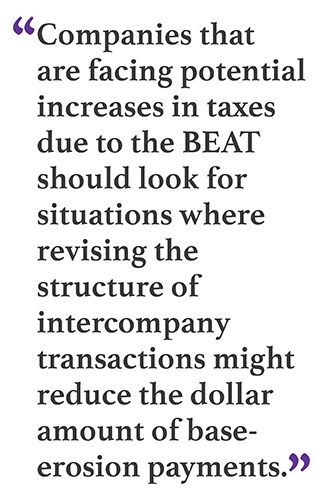
The base erosion and anti-abuse tax known by the acronym "BEAT"was enacted by the Tax Cuts and Jobs Act (TCJA) as a means oflimiting intercompany funds flowing out of the United States. Forcompanies that meet certain criteria, the BEAT acts as analternative minimum tax, with the potential for the additional taxpayable to be significant. As such, the BEAT continues to be asignificant area of focus for multinationals with U.S. operations,particularly large multinationals with material U.S.-outboundintercompany flows.
|Effective management of BEAT exposures is highly specific to thefacts and circumstances of each multinational and requires thoseimpacted to perform critical reviews of operations and supportingstructures that result in material funds flows. Many intercompanyflows that touch the corporate treasury group appear relevant;these could include interest on loans, lease-financing payments,guarantee fees, and service payments to non-U.S. treasurycenters.
|Therefore, treasury professionals must coordinate with theircolleagues in tax and other areas of the company to manage theimpact of intercompany financial flows on any new, and potentiallysubstantial, tax liabilities under the BEAT provision.
||
Understanding the BEAT Provision
On December 2, 2019, the IRS and the U.S. Department of theTreasury issued final regulations implementing the BEAT.
|As context, the BEAT was designed to prevent companies fromreducing their U.S. income tax liabilities through so-called"base-erosion payments" to foreign related entities. Specifically,the BEAT works by effectively charging a multinational the greaterof either its U.S. income tax bill if calculated normally—i.e.,with intercompany payments treated as deductible and using thecorporate tax rate—or a BEAT-adjusted income tax bill, whereincertain intercompany payments are added back to taxable income butmultiplied by a comparatively lower BEAT rate. (The BEAT rate was 5percent for 2018 but increased to 10 percent for 2019 through 2025,and will increase again to 12.5 percent starting in 2026. As such,the BEAT is going to become even more impactful in the future.)
|Intercompany payments from U.S.-based entities to foreignentities that are subject to the BEAT include royalties, servicesfees, interest charges, and other deductible payments (e.g.,depreciation associated with acquired assets). However, somepayments, such as those that are classified as cost of goods sold(e.g., the intercompany purchase of inventory), are notincluded.
|For payment types within the scope of the BEAT, exceptions arefew and far between. The BEAT applies regardless of whetherpayments reflect market prices for the underlying transactions orwhether the multinational would have had to otherwise engage athird party to perform the same functions or services.
||
Identifying Companies Subject to the BEAT Provision
In order for the BEAT to apply, a U.S. corporate taxpayer mustmeet two criteria. First, its annual gross receipts for thethree-year period ending with the preceding taxable year mustaverage more than $500 million. And second, its deductions forbase-erosion payments must exceed 3 percent of total allowabledeductions (2 percent for companies that are banks or registeredsecurities dealers).
|These thresholds cast a wide net. The IRS and U.S. TreasuryDepartment anticipate that the BEAT will impact 103,500 to 114,500U.S. corporate taxpayers.1
|Some companies' supply-chain structures make them more likelythan others to have material intercompany payment flows leaving theUnited States. In our experience, the following situations tend toresult in material outbound payments:
- Companies where U.S. entities rely on foreign related partiesfor financing—e.g., a foreign parent borrows from a third-partybank, then lends to its U.S. subsidiary
- Foreign-headquartered companies with shared service centersbased outside the United States, resulting in U.S.-outboundservices payments—e.g., a U.S. subsidiary pays a service fee to theforeign parent for management services including treasuryservices
- U.S.-headquartered companies whose non-U.S. subsidiaries arecompensated on a cost-plus basis for functions they perform, suchas sales support
- Companies in intellectual property (IP)–intensive industrieswith offshore IP holding companies, which are likely to result inoutbound royalty payments from U.S. entities to the IP holdingcompanies
Any companies with these characteristics—or anotherorganizational structure that results in U.S. entities makingmaterial outbound payments to their foreign counterparts—are morelikely to be subject to the BEAT. It would make sense for treasuryteams to evaluate whether they can reduce cross-border payments torelated parties for treasury-related activities, includingintercompany interest payments, guarantee fees, and fees fortreasury services performed. This is especially true if thecompany's level of revenues or deductions means it is in danger ofcrossing the thresholds that would subject it to the BEAT.
||
Key Considerations
The Treasury Department and the IRS anticipate thatmultinationals are likely to make changes to their intercompanypayment flows to avoid the BEAT. The preamble to the final BEATregulations states that they "recognize that in response to thesefinal regulations … business[es] may alter the way they transactwith related versus unrelated parties. They may make changes tofinancial arrangements, supply-chain arrangements, or the locationsof business activity."
| Which changes an organizationwill make will be very taxpayer-specific and highly dependent onthe applicable facts and circumstances. Many multinationals willprobably work to limit their exposures to the BEAT by managing thenumerator in the 3 percent threshold (2 percent for financialfirms) through optimization of their intercompany paymentstructures.
Which changes an organizationwill make will be very taxpayer-specific and highly dependent onthe applicable facts and circumstances. Many multinationals willprobably work to limit their exposures to the BEAT by managing thenumerator in the 3 percent threshold (2 percent for financialfirms) through optimization of their intercompany paymentstructures.
Within affected corporations, the tax teams have naturallyassumed the primary responsibility for digesting the BEAT rules andfor determining their companies' BEAT positions and (whereapplicable) BEAT liabilities. However, these determinations areinextricably linked to intercompany payments managed by thecorporate treasury function—particularly when such payments arisein the context of intercompany debt transactions; centralizedprocurement or "clearing house" structures, as they relate to cashmanagement responsibilities; and intercompany treasuryservices.
||
Intercompany debt. Interestpayments from U.S. companies to foreign related parties arebase-erosion payments. For companies that are above the BEATthresholds/triggers, issuing new cross-border intercompany debt toa U.S. borrower could result in additional tax payments. Forcompanies that are above the BEAT revenue threshold but below thedeductions trigger, a new issuance could, in theory, push theorganization over the "BEAT cliff"—such that the company mightsuddenly owe BEAT not just on the interest for that particular debtpayment, but on all relevant intercompany royalties, service fees,and interest payments.
|Depending on company-specific facts and circumstances, anorganization in this situation might want to consider the followingactions:
- Seeking relatively lower interest rates for intercompany loanswhere the U.S. entity is the borrower—for example, by applying thesafe harbor rate from a U.S. transfer pricing perspective (i.e.,the applicable federal rate—AFR) or by including features, such assenior status, that reduce the risk of the instrument and thereforereduce the arm's-length borrowing rate.
- Reassessing existing intercompany loans to determine whetherthey could be restructured or refinanced to reduce the size oftheir interest payments, given the current rate environment.
- Borrowing directly from a third-party bank, instead of takingan intercompany loan. Interest paid by the U.S. entity to anexternal financial institution is not a payment to a related partyand so is not subject to the BEAT, although a guarantee fee paid toa related-party guarantor does fall within the scope of theBEAT.
- Opting to utilize third-party debt without a related-partyguarantor, even at a relatively higher interest rate, if thebenefits of reducing outbound related-party transactions (throughelimination of the guarantee fee) outweigh potentially higherinterest rates.
- Restructuring financing arrangements that are pass-throughstructures—for example, where the U.S. entity borrows from anon-U.S. entity with the intention of on-lending to other relatedparties. In this case, a wiser approach might be to routeinstruments more directly, in a manner that avoids the U.S. entityas an intermediary and thus reduces deductions subject to theBEAT.
It is important to note that the final BEAT regulations do notallow for netting of intercompany inflows and outflows in caseswhere the U.S. business makes payments to and receives paymentsfrom the same foreign related party. This means that a U.S. entitywould not be able to net intercompany interest paid and earned toreduce the value of its base-erosion payments.
||
Centralized procurement and clearing housefunctions. Companies that centralizethird-party payments or intercompany payments through procurementcenters or designated clearing houses are more likely to haveintercompany payments that would fall under the BEAT umbrella.That's because these structures increase the likelihood ofintercompany funds flows from U.S. companies to their foreignrelated parties. The same is true for companies that employarrangements where revenue or income is divided among U.S. andnon-U.S. entities that contribute to the generation of thoserevenues or income.
|As a result, we are seeing many companies take steps to identifythe specific scenarios within these structures that are generatingU.S. outflows to foreign related parties, and to eliminate orminimize those outflows. That said, companies often implementcentralized procurement, clearing house, and other similarstructures in order to promote efficiency from a cash managementperspective—to standardize the interface for processing third-partypayments, to streamline transaction flows, to more easily trackpayments, etc. Therefore, corporate tax and treasury teams need towork together, to jointly consider the impact of any potentialchanges and to ensure that such changes result in the optimalalignment of organizational objectives.
||
Intercompany treasuryservices. To the extent that amultinational has centralized treasury functions outside the UnitedStates, the U.S. entity likely makes outbound payments to therelated party as compensation for those services. In some cases,treasury services may have historically been grouped with otherservices (e.g., administrative/back-office activities, managementservices) and compensated for collectively via a single service fee(e.g., at cost-plus). Intercompany payments under such a structurewould be subject to the BEAT.
|Multinationals with this type of structure might consider"unbundling," or bifurcating, the related charges, separating thosethat are excepted from the BEAT from those that are not. Whichservices are excepted? Under the BEAT, an exception applies forservices that are charged at cost—without a markup—under anelective U.S. transfer pricing methodology called the services cost method (SCM).2 If a company were to separate outservices that qualify for the exception from those that do not, thenet effect would be a reduction in the value of foreign relatedpayments subject to the BEAT, without materially overhaulingintercompany transaction flows.
|Specific evaluations with respect to treasury services requirethe team to differentiate among functions that are routine,administrative, or coordinating in nature—and may beSCM-eligible—versus those that are more value-added, such asfinancial risk management activities. Note that functions relatedto the actual financing of a transaction are explicitly excludedfrom SCM exception.
|The new OECD Guidance on Financial Transactionsprovides insights on how to analyze the functions of a treasuryentity beyond the broad bucket of "treasury services." It mayprovide additional assistance with "unbundling" treasury services.From there, the company can make a determination as to whether eachsubset of services is eligible for the SCM.
||
Get a Feel for the BEAT
The final BEAT regulations provide guidance and rules governingthe implementation of the BEAT, against which companies canevaluate strategies to manage, or potentially avoid, additionalfederal income tax due to the BEAT. Companies that are facingpotential increases in taxes due to the BEAT should considerwhether there are steps they may take to reduce their base-erosionpayments. More specifically, they should look for situations whererevising the structure of certain intercompany transactions mightreduce the dollar amount of base-erosion payments made by U.S.legal entities.
|This might be especially relevant for treasury-relatedfunctions, as there could be opportunities for material reductionsin U.S. outbound payments without the need for significantoperational restructuring.
1. Note that the BEAT does notapply to regulated investment companies, real estate investmenttrusts (REITs), or S-corporations.
|2. SCM-eligible services mayinclude those explicitly listed by the IRS in Rev Proc. 2007-13 orthose where a selection of independent companies providing theseservices at arm's length earn a median return of less than 7percent.
|
 Stefanie Perrella isa managing director in Duff & Phelps' transfer pricing practicebased in New York.
Stefanie Perrella isa managing director in Duff & Phelps' transfer pricing practicebased in New York.
|
|
|
 Zachary Held is adirector in Duff & Phelps' transfer pricing practice based inNew York.
Zachary Held is adirector in Duff & Phelps' transfer pricing practice based inNew York.
|
|
|
 Elizabeth Patrun isa director in Duff & Phelps' transfer pricing practice based inChicago.
Elizabeth Patrun isa director in Duff & Phelps' transfer pricing practice based inChicago.
Complete your profile to continue reading and get FREE access to Treasury & Risk, part of your ALM digital membership.
Your access to unlimited Treasury & Risk content isn’t changing.
Once you are an ALM digital member, you’ll receive:
- Critical Treasury & Risk information including in-depth analysis of treasury and finance best practices, case studies with corporate innovators, informative newsletters, educational webcasts and videos, and resources from industry leaders.
- Exclusive discounts on ALM and Treasury & Risk events.
- Access to other award-winning ALM websites including PropertyCasualty360.com and Law.com.
*May exclude premium content
Already have an account? Sign In
© 2024 ALM Global, LLC, All Rights Reserved. Request academic re-use from www.copyright.com. All other uses, submit a request to [email protected]. For more information visit Asset & Logo Licensing.








